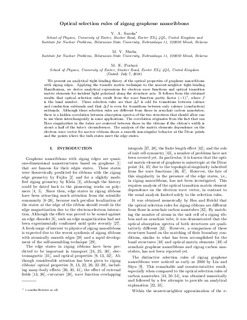Optical selection rules of zigzag graphene nanoribbons
Journal article, Peer reviewed
Accepted version
Permanent lenke
http://hdl.handle.net/11250/2585333Utgivelsesdato
2017Metadata
Vis full innførselSamlinger
- Institutt for fysikk [2712]
- Publikasjoner fra CRIStin - NTNU [38679]
Sammendrag
We present an analytical tight-binding theory of the optical properties of graphene nanoribbons with zigzag edges. Applying the transfer matrix technique to the nearest-neighbor tight-binding Hamiltonian, we derive analytical expressions for electron wave functions and optical transition matrix elements for incident light polarized along the structure axis. It follows from the obtained results that optical selection rules result from the wave function parity factor (−1)J , where J is the band number. These selection rules are that J is odd for transitions between valence and conduction subbands and that J is even for transitions between only valence (conduction) subbands. Although these selection rules are different from those in armchair carbon nanotubes, there is a hidden correlation between absorption spectra of the two structures that should allow one to use them interchangeably in some applications. The correlation originates from the fact that van Hove singularities in the tubes are centered between those in the ribbons if the ribbon width is about a half of the tubes circumference. The analysis of the matrix elements dependence on the electron wave vector for narrow ribbons shows a smooth nonsingular behavior at the Dirac points and the points where the bulk states meet the edge states.
